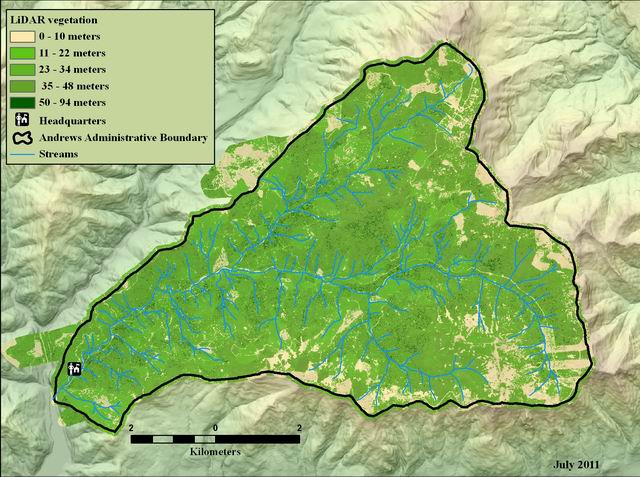Vegetation Height digital elevation model (DEM) from 2008 LiDAR, Andrews Experimental Forest
Raster Dataset

Tags
topography, HJ Andrews Experimental Forest, Landscape Ecology, Oregon, geology, Blue River Watershed, LiDAR, digital elevation model (DEM), Willamette Basin
The LiDAR lazer returns were processed into a representation of the topography of the area of interest with the first returns, also known as the "Highest Hits Digital Elevation Model (DEM)l". The base or bare-earth DEM values were subtracted from the first returns, witht he resulting raster being the height of any vegetation in the area of interest. Values are in meters. The final product is in ESRI GRID digital format, with a 1 meter cell size resolution. Each cell in the GRID has a value that represents the modeled vegetation height at that location. The purpose of the data is to provide users with a very accurate view of the vegetation height of the study area. The data are suitable for creating visualizations, identifying different layers of vegetation, calculataing biomass, and determining crown diameter, tree density, numbers of trees and their relationships to eachother. It is also possible to observe management activities (clear-cutting) and vegetation in meadows.
Watershed Sciences, Inc. (WS) collected Light Detection and Ranging (LiDAR) data from HJ Andrews and the Willamette National Forest (NF) on August 10th and 11th 2008. Total area for this AOI is 17,705 acres. The total area of delivered LiDAR including 100 m buffer is 19,493 acres. This raster contains a vegetation version of the LiDAR (the bare-earth Digital Elevation Model subtarcted from the highest hits DEM) for the Andrews Forest.
There are no credits for this item.
See access and use constraints information.
Extent
West -122.277460 East -122.099580 North 44.282961 South 44.196797
Maximum (zoomed in) 1:5,000 Minimum (zoomed out) 1:50,000